传统文化翻译句子
- 格式:doc
- 大小:49.00 KB
- 文档页数:4
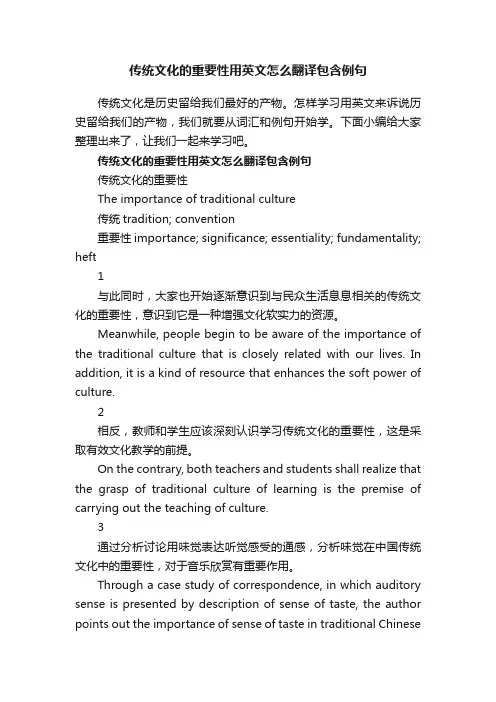
传统文化的重要性用英文怎么翻译包含例句传统文化是历史留给我们最好的产物。
怎样学习用英文来诉说历史留给我们的产物,我们就要从词汇和例句开始学。
下面小编给大家整理出来了,让我们一起来学习吧。
传统文化的重要性用英文怎么翻译包含例句传统文化的重要性The importance of traditional culture传统tradition; convention重要性importance; significance; essentiality; fundamentality; heft1与此同时,大家也开始逐渐意识到与民众生活息息相关的传统文化的重要性,意识到它是一种增强文化软实力的资源。
Meanwhile, people begin to be aware of the importance of the traditional culture that is closely related with our lives. In addition, it is a kind of resource that enhances the soft power of culture.2相反,教师和学生应该深刻认识学习传统文化的重要性,这是采取有效文化教学的前提。
On the contrary, both teachers and students shall realize that the grasp of traditional culture of learning is the premise of carrying out the teaching of culture.3通过分析讨论用味觉表达听觉感受的通感,分析味觉在中国传统文化中的重要性,对于音乐欣赏有重要作用。
Through a case study of correspondence, in which auditory sense is presented by description of sense of taste, the author points out the importance of sense of taste in traditional Chineseculture.4本文对传统声乐艺术和传统声乐理论进行分析,提出在高校声乐教育中传承和发展传统声乐文化的重要性。
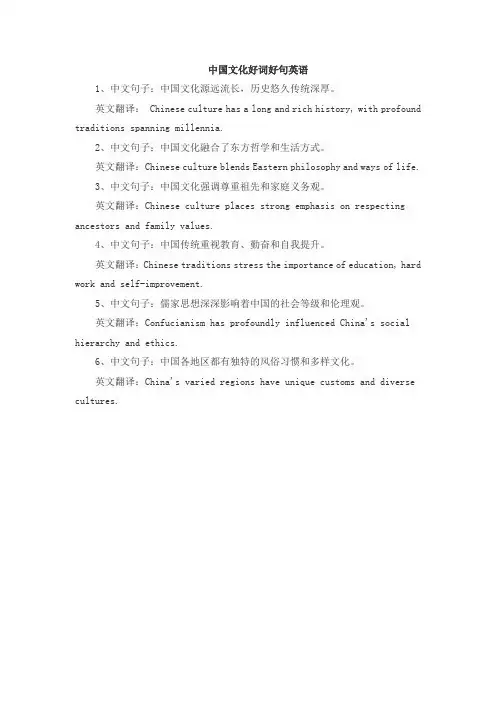
中国文化好词好句英语
1、中文句子:中国文化源远流长,历史悠久传统深厚。
英文翻译: Chinese culture has a long and rich history, with profound traditions spanning millennia.
2、中文句子:中国文化融合了东方哲学和生活方式。
英文翻译:Chinese culture blends Eastern philosophy and ways of life.
3、中文句子:中国文化强调尊重祖先和家庭义务观。
英文翻译:Chinese culture places strong emphasis on respecting ancestors and family values.
4、中文句子:中国传统重视教育、勤奋和自我提升。
英文翻译:Chinese traditions stress the importance of education, hard work and self-improvement.
5、中文句子:儒家思想深深影响着中国的社会等级和伦理观。
英文翻译:Confucianism has profoundly influenced China's social hierarchy and ethics.
6、中文句子:中国各地区都有独特的风俗习惯和多样文化。
英文翻译:China's varied regions have unique customs and diverse cultures.。
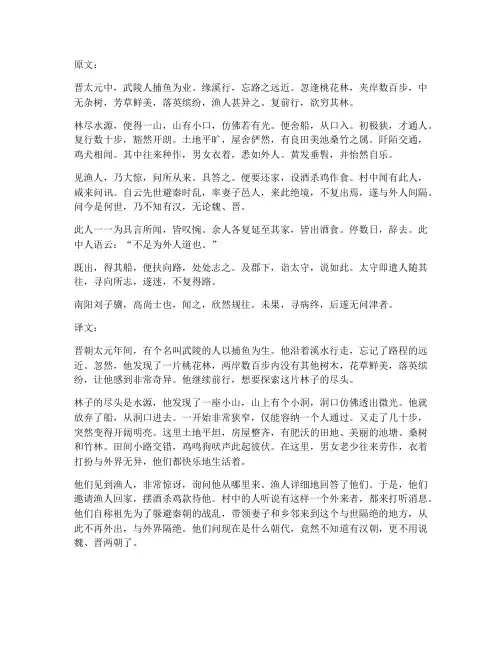
原文:晋太元中,武陵人捕鱼为业。
缘溪行,忘路之远近。
忽逢桃花林,夹岸数百步,中无杂树,芳草鲜美,落英缤纷,渔人甚异之。
复前行,欲穷其林。
林尽水源,便得一山,山有小口,仿佛若有光。
便舍船,从口入。
初极狭,才通人。
复行数十步,豁然开朗。
土地平旷,屋舍俨然,有良田美池桑竹之属。
阡陌交通,鸡犬相闻。
其中往来种作,男女衣着,悉如外人。
黄发垂髫,并怡然自乐。
见渔人,乃大惊,问所从来。
具答之。
便要还家,设酒杀鸡作食。
村中闻有此人,咸来问讯。
自云先世避秦时乱,率妻子邑人,来此绝境,不复出焉,遂与外人间隔。
问今是何世,乃不知有汉,无论魏、晋。
此人一一为具言所闻,皆叹惋。
余人各复延至其家,皆出酒食。
停数日,辞去。
此中人语云:“不足为外人道也。
”既出,得其船,便扶向路,处处志之。
及郡下,诣太守,说如此。
太守即遣人随其往,寻向所志,遂迷,不复得路。
南阳刘子骥,高尚士也,闻之,欣然规往。
未果,寻病终,后遂无问津者。
译文:晋朝太元年间,有个名叫武陵的人以捕鱼为生。
他沿着溪水行走,忘记了路程的远近。
忽然,他发现了一片桃花林,两岸数百步内没有其他树木,花草鲜美,落英缤纷,让他感到非常奇异。
他继续前行,想要探索这片林子的尽头。
林子的尽头是水源,他发现了一座小山,山上有个小洞,洞口仿佛透出微光。
他就放弃了船,从洞口进去。
一开始非常狭窄,仅能容纳一个人通过。
又走了几十步,突然变得开阔明亮。
这里土地平坦,房屋整齐,有肥沃的田地、美丽的池塘、桑树和竹林。
田间小路交错,鸡鸣狗吠声此起彼伏。
在这里,男女老少往来劳作,衣着打扮与外界无异,他们都快乐地生活着。
他们见到渔人,非常惊讶,询问他从哪里来。
渔人详细地回答了他们。
于是,他们邀请渔人回家,摆酒杀鸡款待他。
村中的人听说有这样一个外来者,都来打听消息。
他们自称祖先为了躲避秦朝的战乱,带领妻子和乡邻来到这个与世隔绝的地方,从此不再外出,与外界隔绝。
他们问现在是什么朝代,竟然不知道有汉朝,更不用说魏、晋两朝了。
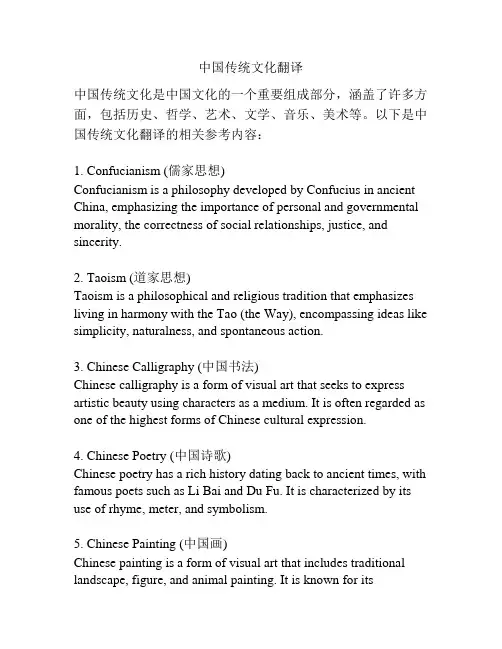
中国传统文化翻译中国传统文化是中国文化的一个重要组成部分,涵盖了许多方面,包括历史、哲学、艺术、文学、音乐、美术等。
以下是中国传统文化翻译的相关参考内容:1. Confucianism (儒家思想)Confucianism is a philosophy developed by Confucius in ancient China, emphasizing the importance of personal and governmental morality, the correctness of social relationships, justice, and sincerity.2. Taoism (道家思想)Taoism is a philosophical and religious tradition that emphasizes living in harmony with the Tao (the Way), encompassing ideas like simplicity, naturalness, and spontaneous action.3. Chinese Calligraphy (中国书法)Chinese calligraphy is a form of visual art that seeks to express artistic beauty using characters as a medium. It is often regarded as one of the highest forms of Chinese cultural expression.4. Chinese Poetry (中国诗歌)Chinese poetry has a rich history dating back to ancient times, with famous poets such as Li Bai and Du Fu. It is characterized by its use of rhyme, meter, and symbolism.5. Chinese Painting (中国画)Chinese painting is a form of visual art that includes traditional landscape, figure, and animal painting. It is known for itscombination of brushwork, ink-wash, and color, and tends to focus on capturing the essence or spirit of the subject matter.6. The Five Elements (五行)The Five Elements theory is a concept in Chinese philosophy that suggests that everything in the world is composed of five basic elements - wood, fire, earth, metal, and water. It is often used to describe the natural world and is also applied in traditional Chinese medicine and feng shui.7. Feng Shui (风水)Feng shui is a traditional Chinese practice that aims to arrange the environment in a way that is harmonious with nature and beneficial to its inhabitants. It involves the placement of objects and structures in a way that enhances the flow of "qi" (life force).8. Tea Culture (茶道)Tea culture is a traditional Chinese practice that originated in ancient China and has developed into a sophisticated art form. It involves the preparation, serving, and enjoyment of tea, as well as its social roles in China's history.9. Chinese Cuisine (中国菜)Chinese cuisine is a diverse culinary tradition that encompasses eight regional cuisines, such as Sichuan, Cantonese, and Shandong. It emphasizes the use of fresh ingredients, delicacy, and balance of flavors.10. Traditional Festivals (中国传统节日)Traditional festivals in China reflect cultural traditions and values,such as Spring Festival (Chinese New Year), Mid-Autumn Festival, and Dragon Boat Festival. They involve a variety of activities, such as family gatherings, eating special foods, and giving and receiving gifts.。
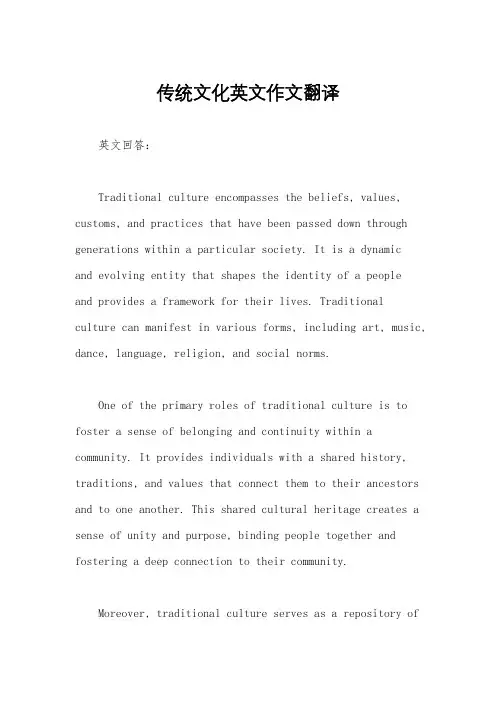
传统文化英文作文翻译英文回答:Traditional culture encompasses the beliefs, values, customs, and practices that have been passed down through generations within a particular society. It is a dynamicand evolving entity that shapes the identity of a peopleand provides a framework for their lives. Traditionalculture can manifest in various forms, including art, music, dance, language, religion, and social norms.One of the primary roles of traditional culture is to foster a sense of belonging and continuity within a community. It provides individuals with a shared history, traditions, and values that connect them to their ancestors and to one another. This shared cultural heritage creates a sense of unity and purpose, binding people together and fostering a deep connection to their community.Moreover, traditional culture serves as a repository ofknowledge and wisdom accumulated over generations. It encompasses a wealth of practical skills, techniques, and beliefs that have been refined and passed down through time. This cultural knowledge enables individuals to navigatetheir lives and adapt to their environment. It provides practical guidance on everything from agriculture and medicine to social etiquette and conflict resolution.In today's rapidly changing world, traditional culture plays a crucial role in preserving cultural diversity and fostering tolerance. In an era of globalization and modernization, it is essential to appreciate and celebrate the unique cultural heritage of different communities. Traditional culture provides a counterbalance to the homogenizing forces of modernity, allowing individuals to maintain their cultural identity and traditions.However, it is important to note that traditionalculture is not static or unchanging. It is constantly evolving and adapting to new circumstances and influences. While it is important to preserve and respect cultural heritage, it is also necessary to allow for cultural changeand innovation. A healthy and vibrant traditional cultureis one that is able to embrace both continuity and adaptation.中文回答:传统文化。
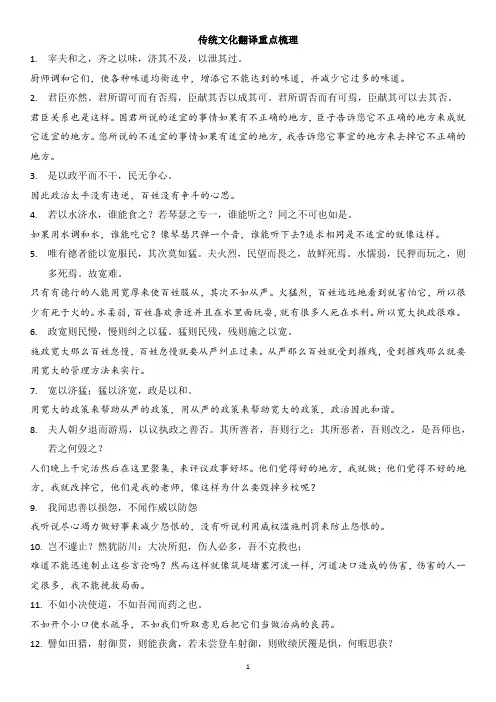
传统文化翻译重点梳理1.宰夫和之,齐之以味,济其不及,以泄其过。
厨师调和它们,使各种味道均衡适中,增添它不能达到的味道,并减少它过多的味道。
2.君臣亦然。
君所谓可而有否焉,臣献其否以成其可。
君所谓否而有可焉,臣献其可以去其否。
君臣关系也是这样。
国君所说的适宜的事情如果有不正确的地方,臣子告诉您它不正确的地方来成就它适宜的地方。
您所说的不适宜的事情如果有适宜的地方,我告诉您它事宜的地方来去掉它不正确的地方。
3.是以政平而不干,民无争心。
因此政治太平没有违逆,百姓没有争斗的心思。
4.若以水济水,谁能食之?若琴瑟之专一,谁能听之?同之不可也如是。
如果用水调和水,谁能吃它?像琴瑟只弹一个音,谁能听下去?追求相同是不适宜的就像这样。
5.唯有德者能以宽服民,其次莫如猛。
夫火烈,民望而畏之,故鲜死焉。
水懦弱,民狎而玩之,则多死焉。
故宽难。
只有有德行的人能用宽厚来使百姓服从,其次不如从严。
火猛烈,百姓远远地看到就害怕它,所以很少有死于火的。
水柔弱,百姓喜欢亲近并且在水里面玩耍,就有很多人死在水利。
所以宽大执政很难。
6.政宽则民慢,慢则纠之以猛。
猛则民残,残则施之以宽。
施政宽大那么百姓怠慢,百姓怠慢就要从严纠正过来。
从严那么百姓就受到摧残,受到摧残那么就要用宽大的管理方法来实行。
7.宽以济猛;猛以济宽,政是以和。
用宽大的政策来帮助从严的政策,用从严的政策来帮助宽大的政策,政治因此和谐。
8.夫人朝夕退而游焉,以议执政之善否。
其所善者,吾则行之;其所恶者,吾则改之,是吾师也,若之何毁之?人们晚上干完活然后在这里聚集,来评议政事好坏。
他们觉得好的地方,我就做;他们觉得不好的地方,我就改掉它,他们是我的老师,像这样为什么要毁掉乡校呢?9.我闻忠善以损怨,不闻作威以防怨我听说尽心竭力做好事来减少怨恨的,没有听说利用威权滥施刑罚来防止怨恨的。
10.岂不遽止?然犹防川:大决所犯,伤人必多,吾不克救也;难道不能迅速制止这些言论吗?然而这样就像筑堤堵塞河流一样,河道决口造成的伤害,伤害的人一定很多,我不能挽救局面。

传统文化英语作文附上中文翻译In today's fast-paced and ever-changing world, it is easy to overlook the value and importance of traditional culture. However, traditional culture is a precious heritage that carries the wisdom, beliefs, and values of our ancestors. It serves as a bridge between the past and the present, connecting us to our roots and shaping our identity.Traditional culture encompasses various aspects, including art, music, literature, customs, and rituals. These cultural elements reflect the unique traditions and heritage of a community or society, offering insights into their way of life, beliefs, and values.By embracing traditional culture, we gain a deeper appreciation for our heritage and history. We learn about the struggles, triumphs, and experiences of those who came before us, gaining a sense of connection and continuity across generations.Moreover, traditional culture provides a sense of belonging and community. It fosters unity and solidarity among individuals who share common traditions and customs,creating a sense of identity and pride in one's cultural heritage.In a rapidly changing world, preserving and promoting traditional culture is essential to maintaining cultural diversity and preserving our collective memory. By celebrating and honoring our traditional culture, we ensure that future generations can continue to learn from and be inspired by the rich tapestry of our cultural heritage.中文翻译:在当今快节奏和不断变化的世界里,很容易忽视传统文化的价值和重要性。
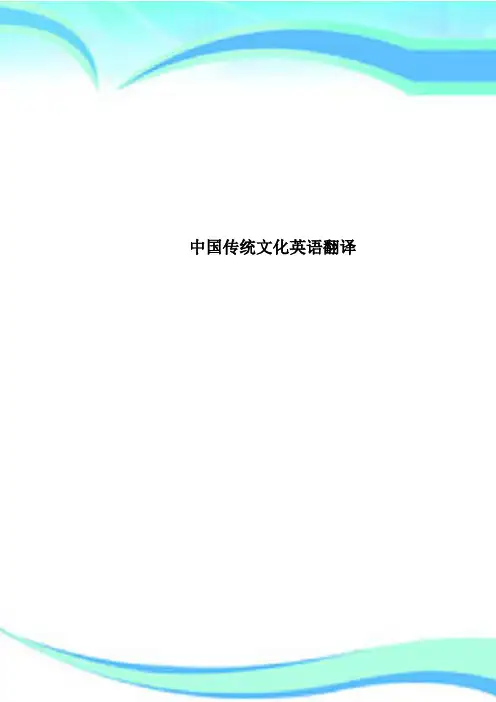
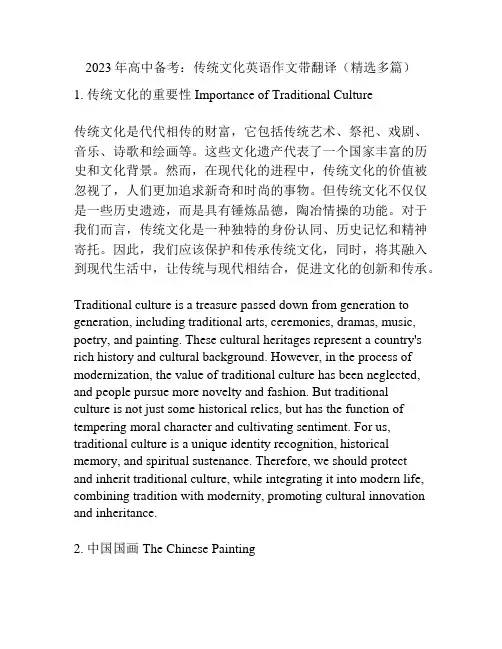
2023年高中备考:传统文化英语作文带翻译(精选多篇)1. 传统文化的重要性 Importance of Traditional Culture传统文化是代代相传的财富,它包括传统艺术、祭祀、戏剧、音乐、诗歌和绘画等。
这些文化遗产代表了一个国家丰富的历史和文化背景。
然而,在现代化的进程中,传统文化的价值被忽视了,人们更加追求新奇和时尚的事物。
但传统文化不仅仅是一些历史遗迹,而是具有锤炼品德,陶冶情操的功能。
对于我们而言,传统文化是一种独特的身份认同、历史记忆和精神寄托。
因此,我们应该保护和传承传统文化,同时,将其融入到现代生活中,让传统与现代相结合,促进文化的创新和传承。
Traditional culture is a treasure passed down from generation to generation, including traditional arts, ceremonies, dramas, music, poetry, and painting. These cultural heritages represent a country's rich history and cultural background. However, in the process of modernization, the value of traditional culture has been neglected, and people pursue more novelty and fashion. But traditionalculture is not just some historical relics, but has the function of tempering moral character and cultivating sentiment. For us, traditional culture is a unique identity recognition, historical memory, and spiritual sustenance. Therefore, we should protectand inherit traditional culture, while integrating it into modern life, combining tradition with modernity, promoting cultural innovation and inheritance.2. 中国国画 The Chinese Painting中国国画是一种源远流长的绘画形式,历史悠久,流传至今,代表着中国传统文化和美学的精髓。
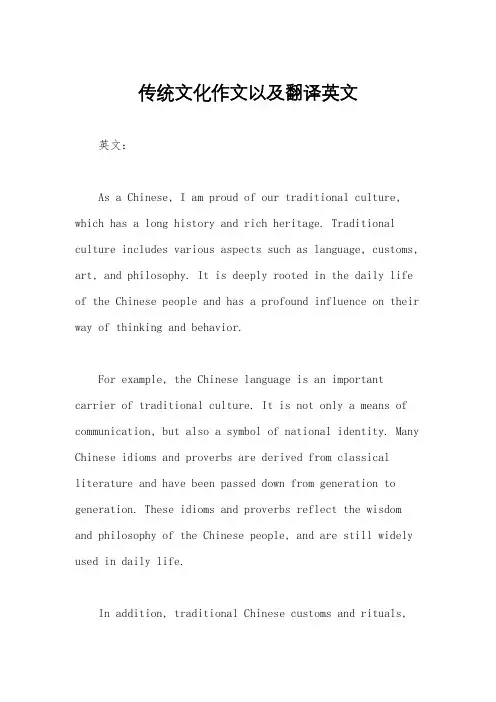
传统文化作文以及翻译英文英文:As a Chinese, I am proud of our traditional culture, which has a long history and rich heritage. Traditional culture includes various aspects such as language, customs, art, and philosophy. It is deeply rooted in the daily life of the Chinese people and has a profound influence on their way of thinking and behavior.For example, the Chinese language is an important carrier of traditional culture. It is not only a means of communication, but also a symbol of national identity. Many Chinese idioms and proverbs are derived from classical literature and have been passed down from generation to generation. These idioms and proverbs reflect the wisdom and philosophy of the Chinese people, and are still widely used in daily life.In addition, traditional Chinese customs and rituals,such as the Spring Festival, Qingming Festival, and Mid-Autumn Festival, are an integral part of traditional culture. These festivals are not only occasions for family reunions and gatherings, but also opportunities for people to express their respect for their ancestors and thenatural world. For example, during the Spring Festival, people will set off fireworks and hang red lanterns todrive away evil spirits and welcome the arrival of the new year.Furthermore, traditional Chinese art, such as calligraphy, painting, and opera, also embodies the essence of traditional culture. For instance, Chinese calligraphyis not only a form of artistic expression, but also a reflection of the Chinese people's pursuit of harmony and balance. The strokes and lines in calligraphy are imbued with profound meaning and convey the thoughts and emotions of the calligrapher.Overall, traditional culture plays a significant rolein shaping the values and beliefs of the Chinese people. It fosters a sense of belonging and identity, and provides aspiritual anchor in the fast-changing modern society.中文:作为一个中国人,我为我们的传统文化感到自豪,它有着悠久的历史和丰富的传承。
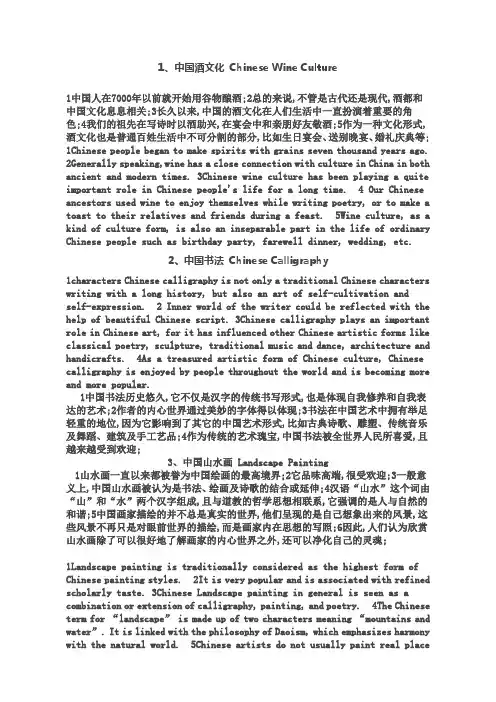
1、中国酒文化Chinese Wine Culture1中国人在7000年以前就开始用谷物酿酒;2总的来说,不管是古代还是现代,酒都和中国文化息息相关;3长久以来,中国的酒文化在人们生活中一直扮演着重要的角色;4我们的祖先在写诗时以酒助兴,在宴会中和亲朋好友敬酒;5作为一种文化形式,酒文化也是普通百姓生活中不可分割的部分,比如生日宴会、送别晚宴、婚礼庆典等; 1Chinese people began to make spirits with grains seven thousand years ago. 2Generally speaking,wine has a close connection with culture in China in both ancient and modern times. 3Chinese wine culture has been playing a quite important role in Chinese people's life for a long time. 4 Our Chinese ancestors used wine to enjoy themselves while writing poetry, or to make a toast to their relatives and friends during a feast. 5Wine culture, as a kind of culture form, is also an inseparable part in the life of ordinary Chinese people such as birthday party, farewell dinner, wedding, etc.2、中国书法Chinese Calligraphy1characters Chinese calligraphy is not only a traditional Chinese characters writing with a long history, but also an art of self-cultivation andself-expression. 2 Inner world of the writer could be reflected with the help of beautiful Chinese script. 3Chinese calligraphy plays an important role in Chinese art, for it has influenced other Chinese artistic forms like classical poetry, sculpture, traditional music and dance, architecture and handicrafts. 4As a treasured artistic form of Chinese culture, Chinese calligraphy is enjoyed by people throughout the world and is becoming more and more popular.1中国书法历史悠久,它不仅是汉字的传统书写形式,也是体现自我修养和自我表达的艺术;2作者的内心世界通过美妙的字体得以体现;3书法在中国艺术中拥有举足轻重的地位,因为它影响到了其它的中国艺术形式,比如古典诗歌、雕塑、传统音乐及舞蹈、建筑及手工艺品;4作为传统的艺术瑰宝,中国书法被全世界人民所喜爱,且越来越受到欢迎;3、中国山水画 Landscape Painting1山水画一直以来都被誉为中国绘画的最高境界;2它品味高端,很受欢迎;3一般意义上,中国山水画被认为是书法、绘画及诗歌的结合或延伸;4汉语“山水”这个词由“山”和“水”两个汉字组成,且与道教的哲学思想相联系,它强调的是人与自然的和谐;5中国画家描绘的并不总是真实的世界,他们呈现的是自己想象出来的风景,这些风景不再只是对眼前世界的描绘,而是画家内在思想的写照;6因此,人们认为欣赏山水画除了可以很好地了解画家的内心世界之外,还可以净化自己的灵魂;1Landscape painting is traditionally considered as the highest form of Chinese painting styles. 2It is very popular and is associated with refined scholarly taste. 3Chinese Landscape painting in general is seen as a combination or extension of calligraphy, painting, and poetry. 4The Chinese term for “landscape” is made up of two characters meaning “m ountains and water”. It is linked with the philosophy of Daoism, which emphasizes harmony with the natural world. 5Chinese artists do not usually paint real placebut imaginary landscape which is no longer about the description of the visible world, but a means of conveying the inner mind. 6People therefore believe that looking at landscape painting is a good way to realize the artist’s inner heart as well as a way to purify their souls.4、中国戏曲 Chinese Opera1在中国,戏曲是一种很流行的戏剧形式,一般来说,可以追溯到唐朝时期,当时的皇帝唐玄宗创立了“梨园”;2如今,许多外国人也很喜欢中国的戏曲;3最吸引他们的则是戏曲的独有风格—画脸谱,它不仅是戏曲中的一大亮点,同时还要求独特的绘画技艺;4每个演员脸上夸张的扮相代表其扮演角色的性格和命运;5熟知戏曲的观众通过观察演员的脸谱和服装就可以知道角色背后的故事;6通常,红色脸谱代表忠诚与勇敢;黑色代表凶猛;黄色和白色代表口是心非;金色和银色代表神秘;7对于中国人,特别是老年人,欣赏戏曲是他们的一大乐趣;1Chinese opera is a popular form of drama in China. In general, it dates back to the Tang Dynasty with Emperor Xuanzong, who founded the “Pear Garden”. 2Now Chinese opera is warmly welcomed by many foreign people. 3What appeals foreigners most might be the distinctive style of facial make-up, which is one of the highlights and requires distinctive techniques of painting.4Exaggerated designs are painted on each performer's face to symbolize a character's personality, and fate. 5Audiences who are familiar with opera can know the story by observing the facial painting as well as the costumes. 6Generally, a red face represents loyalty and bravery; a black face, rough ; yellow and white faces, duplicity; and golden and silver faces, mystery. 7For Chinese, especially older folks, to listen to opera is a real pleasure.5、京剧 Peking Opera1京剧是中国的一种传统艺术;2它是中国戏曲的一种,诞生于于1790年四大徽班Four Great Anhui Troupes入京表演的时候;19世纪中期得到快速发展,到清朝达到全盛阶段;3京剧被看成是中国的文化瑰宝之一;4虽然它被称为京剧,但是它的起源地却是中国的安徽省和湖北省;5京剧起初是一种宫廷表演艺术,而后才慢慢普及到民间;6在数百年前,京剧作为一种新的戏曲形式,无论在哪里进行表演,都饱受欢迎;7而在现代社会中,包括京剧在内的传统戏曲却不大能被年轻人接受,面临着巨大的生存危机;1Peking opera is a traditional art in China. 2It is a kind of Chinese opera which was born when the Four Great Anhui Troupes came to Beijing in 1790, arose in the mid-19th century and was extremely popular in the Qing Dynasty. 3Peking opera is widely regarded as one of the cultural treasures of China. 4Although it is called Beijing opera, its origins are in the Chinese provinces of Anhui and Hubei. 5Peking opera was originally staged for the court and came into the public later. 6Hundreds of years ago, as a new drama form, wherever it was performed, it would be warmly welcomed. 7Unfortunately, in the modern world, traditional operas including Peking Opera have to face the existential crisis, because they are not easily accepted by younger generations.6、昆曲 Kunqu Opera1昆曲是中国古老戏曲中的一种,起源于江苏昆山,拥有600多年的历史;2它是连接过去与现在,中国与世界的纽带,对现今中国的戏曲形式,包括川剧与京剧在内,都产生了重要的影响; 3昆曲蕴含了各种意象美,从音乐、舞蹈到诗歌,人们的精神世界甚至中国人的灵魂,都有所体现;4正因为如此,昆曲在过去广受欢迎,也成了中国文化遗产中最珍贵的部分;5但是现在,昆曲不仅面临着来自大众流行文化的挑战,而且年轻人也对其缺乏兴趣;6只有进行适当的保护,昆曲才能拥有美好的未来;1Kunqu Opera, which originated in the Kunshan region of Jiangsu province, is one of China’s classical operas with a history of more than 600 years. 2Kunqu Opera serves as a link between past and present, China and the world. It has exerted a dominant influence on recent forms of opera in China, including the Sichuan and Beijing operas. 3Kunqu Opera embraced every imaginable beauty, from music and dance, to poetry and people’s spirit world and even very soul of the Chinese nation. 4so that Kunqu Opera was so popular in the past and became the most valuable part s of China’s cultural heritage.5But now, Kunqu Opera is facing competition from mass culture and a lack of interest amongst the young. 6It can only have a bright future when it is protected in a proper way.7、唐诗 Poems of the Tang Dynasty1唐代,是中国古典诗歌的鼎盛时期,在不到300年的时间里,涌现出了许多着名的诗人和诗作;2清朝时编辑的全唐诗Poems of the Tang Dynasty已收录2200多位诗人创作的48900多首诗歌;3这些诗歌让人们深入了解到当时社会生活的各个方面;4中国人很喜欢唐诗,就连小孩子也能背出几首,如李白的静夜思Thoughts in the Silent Night,杜甫的春夜喜雨Good Rain on a Spring Night等等;5唐诗不仅是中国古代文学史上最光辉的一页,而且也是人类文化史中的一个奇迹;1The Tang Dynasty witnessed the peak of Chinese ancient poetry, with many renowned poets and famous works appearing over a period of less than 300 years. 2Poems of the Tang Dynasty edited during the Qing Dynasty has collected more than 48,900 poems written by over 2,200 poets. 3These poems provide an insight into all aspects of the social life of the period. 4Chinese people are very fond of Tang poetry, and even children can recite some from memory, such as Thoughts in the Silent Night by Li Bai, Good Rain on a Spring Night by Du Fu, etc.5Tang poetry not only serves as a most brilliant page in the history of ancient Chinese literature, but is also a miracle in the history of human culture.8、中国武术Chinese Martial Arts/ Kungfu1中国武术拥有悠久的历史,在中国广为流行;2 受中国古典美学所提倡的刚柔并济的影响,,中国武术形成了自己的审美标准;3现在很多人习武是为了健康、娱乐和竞技;4为了更好地传承这一古老的技艺,全国各地开设有很多的武术俱乐部和协会;5自1980年起,一大批武术专业的毕业生被分配到学校里教授武术;6现在很多专家通过将搏斗技巧和健康结合到一起,试着将武术变为一项科学的运动;7他们希望有一天,武术可以作为一项赛事纳入奥运会中;1Chinese martial arts enjoy a long history and great popularity in China. 2Influenced by ancient Chinese aesthetics which advocated a balance between hardness and softness, Chinese martial arts have formed their own aesthetic standards. 3Today, many people practice it to pursue health, entertainment and competition. 4In order to inherit the ancient art, many martial arts clubs and associations have been established across China. 5Since 1980, a large number of graduates majoring in martial arts have been assigned to teach martial arts in schools. 6Many specialists today are tying to turn martialarts into a scientific sport by combining fighting skills with health. 7They hope that one day martial arts will become a sport event at the Olympic Games.9、长城 The Great Wall1长城,作为中国的象征之一,不仅是中国的奇迹,也是整个世界的奇迹;2它始建于春秋战国时期,秦始皇统一中国后,连结了各段长城以抵御外敌入侵;3现存的长城遗迹主要为建于14世纪的明长城;4长城有着两千多年的历史,于1987年被联合国教科文组织列为世界遗产;5现如今,长城仍是世界上最受欢迎的景点之一;1As one of the symbols of China, the Great Wall is a wonder not only to China but also to the whole world. 2The Great Wall was first built in the Spring and Autumn Period and the Warring States Period. After the unification of China, the first Emperor of Qin linked up different sections of the walls to prevent the invasion of the enemies. 3The present preserved Great Wall of China is the major parts built in the 14th century, called Ming Great Wall. 4With a long history of more than 2,000 years, the Great Wall of China was listed as World Heritage by UNESCO in 1987. 5Until now, the Great Wall is still one of the most popular attractions in the world.10、故宫 The Imperial Palace1故宫又名紫禁城,位于北京市中心,占地面积72万平方米;2它拥有众多的庭院,四面有高墙和护城河保护;3明清两代的皇帝和他们的家眷以及数百名宫女、太监曾在这里居住;4紫禁城于明朝1420年建成,普通百姓不能进入;5在1924年清朝末代皇帝被逐出故宫后,故宫于1925年变成了故宫博物院并对外开放;1Standing/Lying in the center of Beijing, the Imperial Palace, also known as the Forbidden City, covers an area of 720,000 square meters. 2It consists of dozens of courtyards and is protected by high walls and a moat on all four sides. The emperors of two dynasties. 3the Ming and the Qing, lived here with their families and hundreds of court ladies and palace eunuchs. 4The Forbidden City was completed in 1420 during the Ming Dynasty, which was not accessible to the common people. 5The Palace was converted into a museum in 1925 and has been open to the public after the last emperor of the Qing Dynasty was driven out of the Palace in 1924.。
英语四级段落翻译(中国传统文化)一、对龙图腾他的崇拜在中国大约已绵延了八千多年。
中国龙是古人将鱼、蛇、马、牛等动物与云雾、雷电等自然天象集合而成的一种神物。
中国龙的形成与中华民族的多元融合过程同步。
在中国人的心目中,龙具有振奋腾飞、开拓变化的寓意和团结凝聚的精神。
Dragon totem worship in China has been around for the last 8,000 years. The ancients in China considered the dragon (or loong) a fetish that combines animals including the fish, snake, horse and ox with cloud, thunder, lightning and other natural celestial phenomena. The Chinese dragon was formed in accordance with the multicultural fusion process of the Chinese nation. To the Chinese, the dragon signifies innovation and cohesion.二、秧歌舞是中国汉族的一种民间传统舞蹈,通常在北方省份表演。
秧歌舞者通常穿上明亮多彩的表演服装,他们的表演动作有力迅速。
在农历春节、元宵节等节日期间,人们一旦听到锣鼓声,不管外面天气有多冷,他们都会蜂拥到街上看秧歌舞表演。
近年来,中国东北某些城市的老年人自发组织了了秧歌队,队员常年通过跳秧歌舞来保持健康,同事他们也乐在其中。
Yangko is one of tradition folk dance of Han in China. It is usually performed in northern provinces. The dancers usually wear colorful and light costumes, and the performance is powerful and rapid. During some festivals such as Spring Festival, Lantern Festival, if people hear the sound of drum and gong, no matter how cold the weather is , they will come to street and appreciate the Yangko. Recent years, the old people in city of east-northern of China organized the team of Yangko by themselves, the teamers keep their health by dancing Yangko the whole year.三、长城是人类创造的世界奇迹之一。
一、对龙图腾他的崇拜在中国大约已绵延了八千多年。
中国龙是古人将鱼、蛇、马、牛等动物与云雾、雷电等自然天象集合而成的一种神物。
中国龙的形成与中华民族的多元融合过程同步。
在中国人的心目中,龙具有振奋腾飞、开拓变化的寓意和团结凝聚的精神。
Chinese Dragon Dragon totem worship in China has been around for the last 8,000 years. The ancients in China considered the dragon (or loong) a fetish that combines animals including the fish, snake, horse and ox with cloud, thunder, lightning and other natural celestial phenomena. The Chinese dragon was formed in accordance with the multicultural fusion process of the Chinese nation. To the Chinese, the dragon signifies innovation and cohesion.二、秧歌舞是中国汉族的一种民间传统舞蹈,通常在北方省份表演。
秧歌舞者通常穿上明亮多彩的表演服装,他们的表演动作有力迅速。
在农历春节、元宵节等节日期间,人们一旦听到锣鼓声,不管外面天气有多冷,他们都会蜂拥到街上看秧歌舞表演。
近年来,中国东北某些城市的老年人自发组织了了秧歌队,队员常年通过跳秧歌舞来保持健康,同事他们也乐在其中。
Yangko is one of tradition folk dance of Han in China.It is usually performed in northern provinces. The dancers usually wear colorful and light costumes, and the performance is powerful and rapid. During some festivals such as Spring Festival, Lantein Festival, if people hear the sound of drum and gong, no matter how cold the weather is , they will come to street and appreciate the Yangko. Recent years, the old people in city of east-northern of China organized the team of Yangko by themselves, the teamers keep their health by dancing Yangko the whole year.三、长城是人类创造的世界奇迹之一。
1.元宵节:the Lantern Festival2. 刺绣:embroidery3. 重阳节:Double-Ninth Festival4. 清明节:Tomb sweeping day5. 剪纸:Paper Cutting6. 书法:Calligraphy7. 对联:(Spring Festival) Couplets8. 象形文字:Pictograms/Pictographic Characters10.四合院:Siheyuan/Quadrangle11.战国:Warring States 春秋the Spring and Autumn12.风水:Fengshui 15.集体舞:Group Dance17.红白喜事:Weddings and Funerals18.中秋节:Mid-Autumn Day19.结婚证:Marriage Certificate20.儒家文化:Confucian Culture22.古装片:Costume Drama23.武打片:Chinese Swordplay Movie25.一国两制:One Country, Two Systems26.火锅:Hot Pot28.《诗经》:The Book of Songs29.素质教育:Essential-qualities-oriented Education30.《史记》:Historical Records/Records of the Grand Historian31.三国演义:Romance of the Three Kingdoms. 红楼梦:A Dream in Red Mansions.32.《西游记》:The Journey to the West.34.针灸:Acupuncture36.中国特色的社会主义:Chinese-charactered Socialist/Socialist with Chinese characteristics38.孟子:Mencius 孔子:Confucius 39.亭/阁:Pavilion/ Attic40.大中型国有企业:Large and Medium-sized State-owned Enterprises41.火药:gunpowder.42.农历:Lunar Calendar 43.印/玺:Seal/Stamp 44.物质精神文明建设:The Construction of Material Civilization and Spiritual Civilization45.京剧:Beijing Opera/Peking Opera46.秦腔:Crying of Qin People/Qin Opera47.太极拳:…….48.独生子女证:The Certificate of One-child49.天坛:Altar of Heaven in Beijing51.红双喜:Double Happiness54.莲藕:Lotus Root56.故宫博物院:The Palace Museum57.相声:Cross-talk59.北京烤鸭:Beijing Roast Duck61.烟花爆竹:fireworks and firecracker62.敦煌莫高窟:Mogao Caves64.香港澳门同胞:Compatriots from Hong Kong and Macao65.文化大革命:Cultural Revolution67.门当户对:Perfect Match/Exact Match68.《水浒》:Water Margin/Outlaws of the Marsh70.文房四宝(笔墨纸砚):"The Four Treasure of the Study" "Brush, Inkstick, Paper, and Inkstone"71.兵马俑:cotta Warriors/ Terracotta Army72.旗袍:cheongsam.73 The Four Great Inventions of the Chinese people in ancient times are papermaking, printing, the compass and gunpowder.中国古代四大发明分别是造纸术,印刷术,指南针和火药。
传统文化英语作文带翻译80词传统文化是一国宝贵的文化遗产,反映了民族的传统习俗、价值观念和审美情趣。
中国传统文化源远流长,博大精深,如中国的书法、绘画、音乐、戏曲等,将中华民族的智慧和美感得以传承。
同时,传统文化也是世界文化的瑰宝,为人类文明的发展做出了重要贡献。
保护和传承传统文化是我们每个人的责任,让其在当今社会焕发新的生机,与现代文明相辉映。
Tradition culture is a precious cultural heritage of a country, reflecting the traditional customs, values, and aesthetics of a nation. Chinese traditional culture has a long history, rich and profound, such as Chinese calligraphy, painting, music, opera, which have inherited the wisdom and beauty of the Chinese nation. At the same time, traditional culture is also a treasure of world culture, making important contributions to the development of human civilization. Protecting and inheriting traditional culture is the responsibility of each of us, allowing it to shine with new vitality in today’s society and complementing modern civilization.。
中国传统文化英文范文English:Chinese traditional culture is rich and diverse, embodying the core values and beliefs that have been passed down through generations. One of the key aspects of Chinese traditional culture is filial piety, which emphasizes the respect and devotion that children should show towards their parents and ancestors. Another important element is Confucianism, with its emphasis on moral virtues, harmony, and social order. Chinese traditional culture also values reverence for the elderly, the importance of maintaining strong family ties, and the significance of rituals and ceremonies in daily life. Art forms such as calligraphy, painting, music, and poetry have long been revered in Chinese culture, reflecting the deep appreciation for aesthetics and craftsmanship. Traditional Chinese medicine, martial arts, and cuisine are also integral parts of Chinese traditional culture, showcasing the holistic approach to health and well-being. Overall, Chinese traditional culture provides a comprehensive understanding of the history, values, and practices that have shaped Chinese society for centuries.中文翻译:中国传统文化丰富多样,体现了代代相传的核心价值观念和信仰。
中国传统文化中英文翻译1.元宵节:Lantern Festival2.刺绣:embroidery3.重阳节:Double-Ninth Festival4.清明节:Tomb sweeping day5.剪纸:Paper Cutting6.书法:Calligraphy7.对联:(Spring Festival) Couplets8.象形文字:Pictograms/Pictographic Characters9.人才流动:Brain Drain/Brain Flow10.四合院:Siheyuan/Quadrangle11.战国:Warring States12.风水:Fengshui/Geomantic Omen13.铁饭碗:Iron Bowl14.函授部:The Correspondence Department15.集体舞:Group Dance16.黄土高原:Loess Plateau17.红白喜事:Weddings and Funerals18.中秋节:Mid-Autumn Day19.结婚证:Marriage Certificate20.儒家文化:Confucian Culture21.附属学校:Affiliated school22.古装片:Costume Drama23.武打片:Chinese Swordplay Movie24.元宵:Tangyuan/Sweet Rice Dumpling (Soup)25.一国两制:One Country, Two Systems26.火锅:Hot Pot27.四人帮:Gang of Four28.《诗经》:The Book of Songs29.素质教育:Essential-qualities-oriented Education30.《史记》:Historical Records/Records of the Grand Historian31.大跃进:Great Leap Forward (Movement)32.《西游记》:The Journey to the West33.除夕:Chinese New Year’s Eve/Eve of the Spring F estival34.针灸:Acupuncture35.唐三彩:Tri-color Pottery of the Tang Dynasty/ The Tang Tri-colored pottery36.中国特色的社会主义:Chinese-charactered Socialist/Socialist with Chinese characteristics37.偏旁:radical38.孟子:Mencius39.亭/阁:Pavilion/ Attic40.大中型国有企业:Large and Medium-sized State-owned Enterprises41.火药:gunpowder42.农历:Lunar Calendar43.印/玺:Seal/Stamp44.物质精神文明建设:The Construction of Material Civilization and Spiritual Civilization45.京剧:Beijing Opera/Peking Opera46.秦腔:Crying of Qin People/Qin Opera47.太极拳:Tai Chi48.独生子女证:The Certificate of One-child49.天坛:Altar of Heaven in Beijing50.小吃摊:Snack Bar/Snack Stand51.红双喜:Double Happiness52.政治辅导员:Political Counselor/School Counselor53.春卷:Spring Roll(s)54.莲藕:Lotus Root55.追星族:Star Struck56.故宫博物院:The Palace Museum57.相声:Cross-talk/Comic Dialogue58.下岗:Lay off/Laid off59.北京烤鸭:Beijing Roast Duck60.高等自学考试:Self-taught Examination of Higher Education61.烟花爆竹:fireworks and firecracker62.敦煌莫高窟:Mogao Caves63.电视小品:TV Sketch/TV Skit64.香港澳门同胞:Compatriots from Hong Kong and Macao65.文化大革命:Cultural Revolution66.长江中下游地区:The Mid-low Reaches of Yangtze River67.门当户对:Perfect Match/Exact Match68.《水浒》:Water Margin/Outlaws of the Marsh69.中外合资企业:Joint Ventures70.文房四宝(笔墨纸砚):"The Four Treasure of the Study" "Brush, Inkstick, Paper, and Inkstone"71.兵马俑:cotta Warriors/ Terracotta Army。
2013年12月改革后四六级段落翻译考纲新增考点(1)“中国传统文化”必备词句2013年12月四六级考纲关于翻译题有两点大纲变动1、句子翻译改为段落汉译英翻译2、考试范围由“校园文化、民生发展、科技兴国、生命科学、求职就业”改为“校园文化、社会生活、餐饮娱乐、民生发展、科技兴国、生命科学、求职就业、新兴学科发展、中国传统文化”,其中亮点就是新增了难度较大的文化领域。
为此,针对传统文化,需要掌握以下文化语句的通用表达,必背16句! 一、对龙图腾他的崇拜在中国大约已绵延了八千多年。
中国龙是古人将鱼、蛇、马、牛等动物与云雾、雷电等自然天象集合而成的一种神物。
中国龙的形成与中华民族的多元融合过程同步。
在中国人的心目中,龙具有振奋腾飞、开拓变化的寓意和团结凝聚的精神。
Chinese Dragon Dragon totem worship in China has been around for the last 8,000 years. The ancients in China considered the dragon (or loong) a fetish that combines animals including the fish, snake, horse and ox with cloud, thunder, lightning and other natural celestial phenomena. The Chinese dragon was formed in accordance with the multicultural fusion process of the Chinese nation. To the Chinese, the dragon signifies innovation and cohesion.二、秧歌舞是中国汉族的一种民间传统舞蹈,通常在北方省份表演。
秧歌舞者通常穿上明亮多彩的表演服装,他们的表演动作有力迅速。
在农历春节、元宵节等节日期间,人们一旦听到锣鼓声,不管外面天气有多冷,他们都会蜂拥到街上看秧歌舞表演。
近年来,中国东北某些城市的老年人自发组织了了秧歌队,队员常年通过跳秧歌舞来保持健康,同事他们也乐在其中。
Yangko is one of tradition folk dance of Han in China.It is usually performed in northern provinces. The dancers usually wear colorful and light costumes, and the performance is powerful and rapid. During some festivals such as Spring Festival, Lantein Festival, if people hear the sound of drum and gong, no matter how cold the weather is , they will come to street and appreciate the Yangko. Recent years, the old people in city of east-northern of China organized the team of Yangko by themselves, the teamers keep their health by dancing Yangko the whole year.三、长城是人类创造的世界奇迹之一。
如果你到了中国却没去过长城,就想到了巴黎没有去看看菲尔铁塔,或者就像到了埃及没有去看金字塔一样。
人们常说:“不到长城非好汉。
”实际上,长城最初只是一些断断续续的城墙,直到秦朝统一中国后才将其连城长城。
然而,今天我们看到的长城——东起山海关,西至嘉峪关——大部分都是在明代修建的。
The Great Wall is one of the wonders of the world that created by human beings! If you come to China without climbing the Great Wall, it's just like going Paris without visiting the Eiffel Tower; or going to Egypt without visiting the Pyramids! Men often say, "He who doest not reach the Great Wall is not a true man."In fact, it began as independent walls for different states when it was first built, and did not become the "Great Wall" until the Qin Dynasty. However, the wall we see today, starting from Shanhaiguan Pass in the east to Jiayunguan Pass in the west, was mostly built during the Ming Dynasty.四、饺子是深受中国人民喜爱的传统食品。
相传为古代医圣张仲景发明。
饺子的制作是包括:1)擀皮、2)备馅、3)包馅水煮三个步骤。
其特点是皮薄馅嫩,味道鲜美,形状独特,百食不厌。
民间有“好吃不过饺子”的俗语。
中国人接亲待客、逢年过节都有包饺子吃的习俗,寓意吉利。
对崇尚亲情的中国人来说,“更岁交子”吃饺子,更是欢度除夕、辞旧迎新必不可少的内容。
Dumplings Dumplings are one of the Chinese people’s favorite traditional dishes. According to an ancient Chinese legend, dumplings were first made by the medical saint---Zhang Zhongjing. There are three steps involved in making dumplings: 1) make dumpling wrappers out of dumpling flour; 2) prepare the dumpling stuffing; 3) make dumplings and boil them. With thin and elastic dough skin, fresh and tender stuffing, delicious taste, and unique shapes, dumplings are worth eating hundreds of times. There’s an old saying that claims, “Nothing could be more delicious than dumplings”. During t he Spring Festival and other holidays, or when treating relatives and friends, Chinese people like to follow the auspicious custom of eating dumplings. To Chinese people who show high reverence for family love, having dumplings at the moment the old year is replaced by the new is an essential part of bidding farewell to the old and ushering in the new year.五、针灸是中医学的重要组成部分。
按照中医的经络理论,针灸疗法主要是通过疏通经络、调和气血,来达到阴阳归于平衡,使脏腑趋于调和之目的。
其特点是“内病外治”。
主要疗法是用针刺入病人身体的一定穴位,或用艾火的温热刺激烧灼病人的穴位,以达到刺激经络。
治疗病痛的目的。
针灸以其独特的优势,流传至今并传播到了世界,与中餐、功夫、中药一起被海外誉为中国的“新四大国粹”。
Acupuncture Acupuncture is an important part of traditional Chinese medicine (TCM). In accordance with the “main and collateral channels” theory in TCM, the purpose of acupuncture is to dredge the channel and regulate qi and blood, so as to keep the body’s yin and yang balanced and achieve reconciliation between the internal orga ns. It features in traditional Chinese medicine that “internal diseases are to be treated with external therapy”. The main therapy of acupuncture involves using needles to pierce certain acupoints of the patient’s body, or adopting moxibustion to stimulate the patient’s acupoints so as to stimulate the channels and relieve pain. With its unique advantages, acupuncture has been handed down generation after generation and has now spread all over the world. Nowadays, acupuncture, along with Chinese food, kung fu (otherwise known as Chinese martial arts), and traditional Chinese medicine, has been internationally hailed as one of the “four new national treasures.”六、中国功夫即中国武术,是将技击寓于搏斗和套路运动之中的中国传统体育项目,承载着丰富的中国民族传统文化。